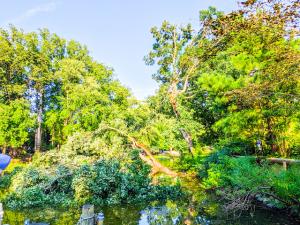Care and age of oaks and treasured old trees
How do you tell a tree’s age? Most people know the growth rings can be counted but that requires cutting the tree down to accomplish. What about the age of a living tree?
Trees grow at different rates for varying reasons such as their genetic disposition by type, climate, temperatures, rainfall, soil quality, fertility and even pest problem history.
There is a formula for estimating tree age. Every tree type has a growth rate factor. You can use a tape measure around the trunk at 4.5 feet above grade to get circumference in inches; then divide the circumference by 3.14 to get the diameter. Then multiply that diameter by the tree’s DBH growth rate factor. DBH means diameter at breast height, defined as about 4.5 feet from the highest point of ground at the tree's base. DBH measurements can be used to estimate the volume, biomass, and carbon storage of trees, as well as age.
Following are the DBH growth rate factors for some common local trees: American beech 6.0, white oak 5.0, red oak 4.0, loblolly pine 5.0, ironwood 7.0, dogwood 7.0, redbud 7.0, red maple 4.5, silver maple 3.0, sugar maple 5.0, hackberry 7.0, river birch 3.5, hickory 7.5, walnut 4.5, black cherry 5.0, sycamore 4.0, honey locust 3.0, sweet gum 4, tulip poplar 3.0.
Many big old trees need special care and awareness of their physical properties. Large old oaks are often hollow quite far up, so the support relies on the outer few inches of living fibers and cells. The recommendation is to lighten the load on old trees by shortening some branches if overbalanced on one side, or if the trunk is leaning, or a major branch crotch is too steep or too narrow an angle.
The strongest tree branches are 90 degrees, right angles, growing sideways from the trunk, not V-shaped, which is weak and easily splits off. When pruning young trees, one should remove all branches that join the trunk in a V-shaped connection, to keep it growing strong for its long future.
A recently fallen white oak on Red Mill Pond beside Mill Pond Garden had an approximate diameter of 30 inches. Multiplying that by the DBH growth rate factor for white oak of 5.0 equals an approximate age of 150 years.
This mighty tree was leaning with its long, heavy branches mostly over the water, causing it finally to split and fall. In the photo, one can see the hollow inside and another factor often seen in old tall trees, a black, burned-out core where lightning struck the tree in the past.
Old trees sometimes survive lightning strikes, but that weakens them. The moment lightning strikes, the tree's cell water turns into gas, expanding, causing the tree's outer layers to explode outward. This effect is catastrophic; 50 percent of trees struck by a bolt die immediately, while others suffer extensive damage, making them vulnerable to diseases.
For very valuable or historic old trees one can have a lightning rod installed on them to protect them as was done to the famous Wye Oak in Wye, Md. There are many now historic large old trees in Lewes that deserve such protection but do not have any. For historic or treasured trees, call an arborist for a consultation to assess the tree and suggest or perform needed amenities for continued thriving.
Oaks can tolerate fire, the onslaught of repeated insect infestations, and prolonged periods of drought. And some oaks can live well past 1,000 years. The oldest oak on Delmarva, a white oak, was the Wye Oak, which collapsed at the approximate age of 460 years. Within the life of an average oak tree, it will grow over 3 million acorns - its seeds. A mature tree will support over 500 million living root tips.
Our Delaware oaks (white oak, black oak, bur oak, pin oak, willow oak, post oak, sawtooth oak, swamp white oak, saw tooth oak, red oak, and some inter-species hybrids) make Delaware one of the richest oak tree habitats in the world. Oaks rely upon wind, not insects or birds, to spread their pollen.
Oaks are a key native species for most of our wildlife. Regional scientist Doug Tallamy reports that over 500 species of caterpillars prey on oak foliage in spring, and these caterpillars are the main source of food for all baby birds. Blue jays and oaks have evolved together. These birds depend upon acorns as a food source and cache them throughout the forest. Oaks depend upon jays to disseminate their seeds. Those acorns that aren’t eaten eventually become trees. Oak acorns feed ducks, turkeys, squirrels, jays, deer, groundhogs, small mammals, feral pigs and humans.
A mature oak tree can grow 120 feet tall with a crown 120 feet wide, providing habitat for over 5,000 species of plants, animals, insects, fungus and bacteria. The great oaks are mother species for all forest ecology and wildlife.
For thousands of years, people and cultures have depended upon oaks and their acorns as their staple food source. In Tunisia, oak means "meal-bearing tree." People from Europe and Asia and the Native Americans of California all collected acorns, soaked them, mashed them and made cakes or soups. One mature white oak tree can throw 302 to 500 pounds of acorns per year.
In stone age times, for the indigenous people who lived here , a whole family could be supported year-round by the acorns of one big oak tree under which they could live, using the fallen dead wood for fires for warmth. What a sustainer! If Delaware’s commercial food sources ever failed, its people might survive on the historic locals’ diet of acorn cakes.
If you plant or preserve an oak tree, you have given a gift to the future – oxygen, shade, bird habitat, shelter, food, and abundant wildlife.
Michael Zajic is the owner and director of Mill Pond Garden. To learn more, go to millpondgarden.com.






















































